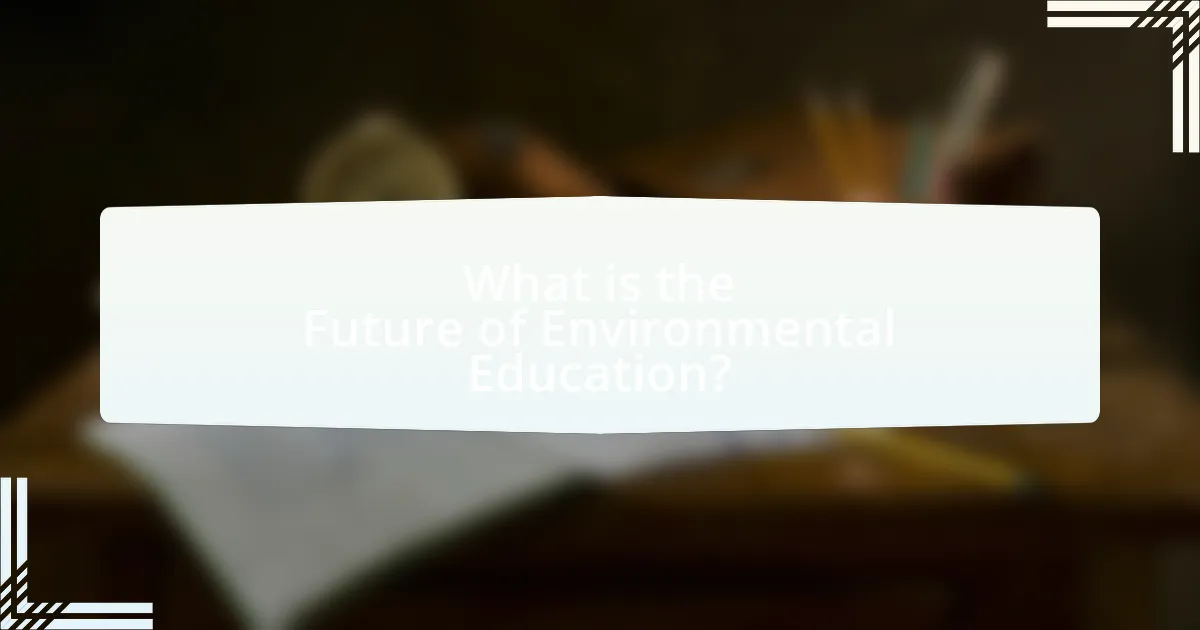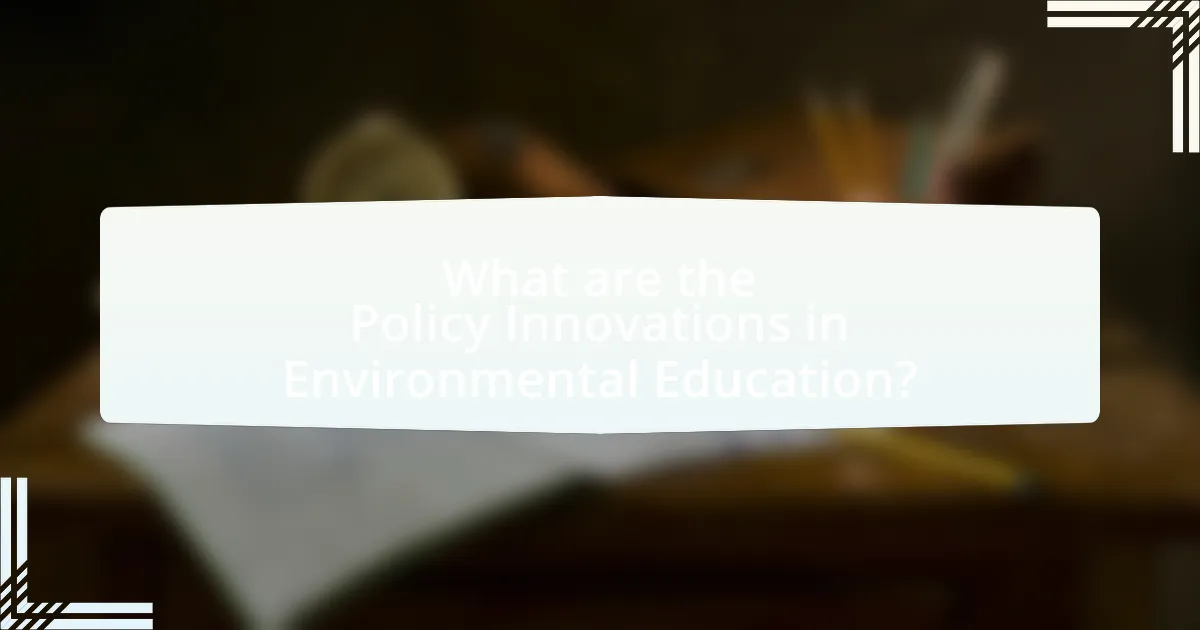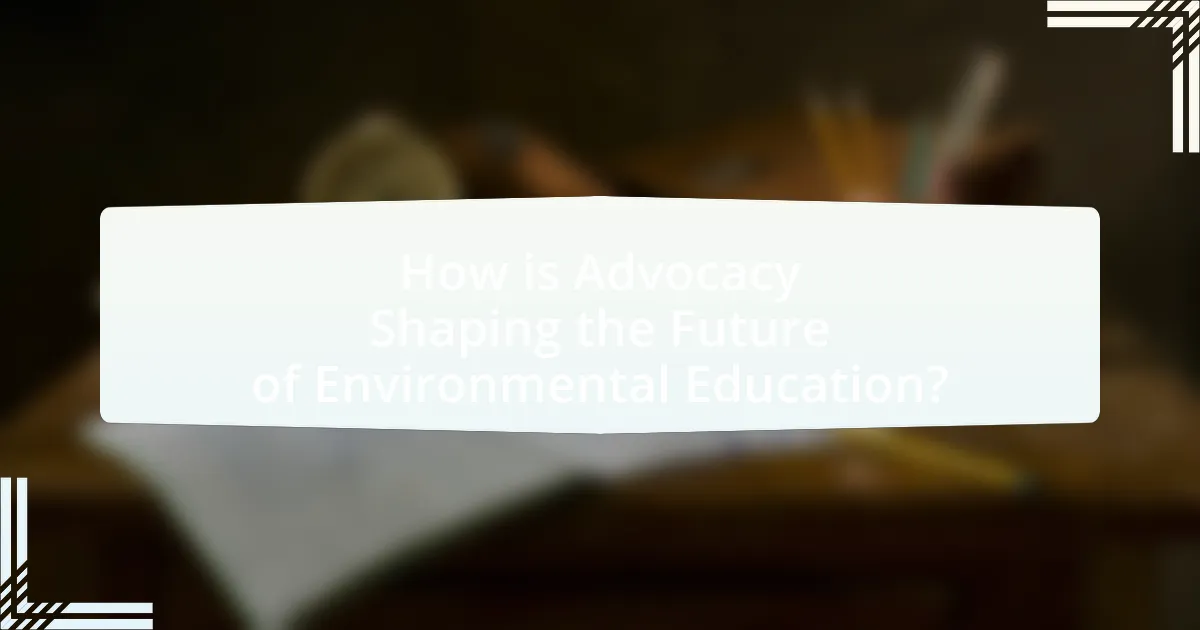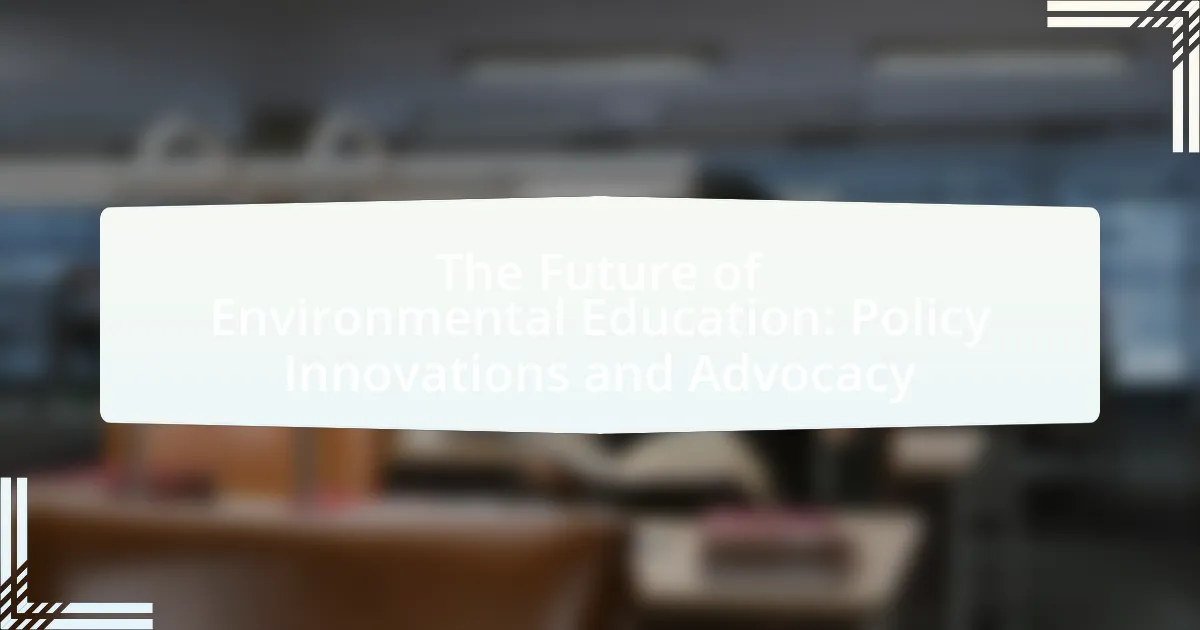The article focuses on the future of environmental education, emphasizing the integration of sustainability into curricula and the promotion of critical thinking regarding environmental issues. It highlights key trends such as the incorporation of technology, experiential learning, and interdisciplinary approaches that enhance student engagement and environmental literacy. The article also discusses the role of policy innovations and advocacy in shaping educational frameworks, including the influence of international agreements and the importance of community engagement. Additionally, it outlines effective strategies for stakeholders, including educators and NGOs, to collaborate and advocate for improved environmental education policies, ultimately fostering a generation equipped to address pressing ecological challenges.

What is the Future of Environmental Education?
The future of environmental education is increasingly focused on integrating sustainability into curricula and fostering critical thinking about environmental issues. This shift is driven by the urgent need to address climate change and biodiversity loss, as evidenced by the United Nations’ Sustainable Development Goal 4.7, which emphasizes education for sustainable development. Educational institutions are adopting innovative teaching methods, such as experiential learning and interdisciplinary approaches, to engage students actively. Research indicates that programs incorporating hands-on experiences and community involvement significantly enhance students’ environmental literacy and advocacy skills.
How is environmental education evolving in response to global challenges?
Environmental education is evolving to address global challenges by integrating sustainability into curricula and promoting interdisciplinary approaches. This evolution is driven by the urgent need to tackle issues such as climate change, biodiversity loss, and social equity. For instance, the United Nations Sustainable Development Goals emphasize education as a key tool for fostering sustainable practices, leading to the incorporation of these goals into educational frameworks worldwide. Additionally, innovative teaching methods, such as experiential learning and community engagement, are being adopted to enhance students’ understanding of environmental issues and empower them to take action. Research indicates that programs focusing on real-world problem-solving significantly improve students’ environmental literacy and engagement, demonstrating the effectiveness of this evolving approach.
What are the key trends shaping the future of environmental education?
Key trends shaping the future of environmental education include the integration of technology, a focus on experiential learning, and an emphasis on interdisciplinary approaches. The integration of technology, such as virtual reality and online platforms, enhances accessibility and engagement, allowing learners to explore environmental issues in immersive ways. Experiential learning, which involves hands-on activities and real-world problem-solving, fosters deeper understanding and connection to environmental challenges. Additionally, interdisciplinary approaches that combine science, social studies, and the arts promote a holistic understanding of environmental issues, reflecting the interconnectedness of ecological, economic, and social factors. These trends are supported by research indicating that active and engaging educational methods significantly improve retention and application of knowledge in environmental contexts.
How do technological advancements influence environmental education?
Technological advancements significantly enhance environmental education by providing innovative tools and platforms for learning. These advancements, such as online courses, interactive simulations, and mobile applications, facilitate access to information and resources, making environmental education more engaging and effective. For instance, the use of virtual reality allows students to experience ecosystems and environmental challenges firsthand, fostering a deeper understanding of ecological issues. Additionally, data analytics and geographic information systems (GIS) enable educators to present real-time environmental data, enhancing the relevance and immediacy of the subject matter. Research indicates that technology integration in education can improve student engagement and retention rates, thereby strengthening the overall impact of environmental education initiatives.
Why is environmental education important for sustainable development?
Environmental education is crucial for sustainable development because it empowers individuals and communities to make informed decisions that positively impact the environment. By fostering awareness and understanding of ecological principles, environmental education encourages sustainable practices, such as conservation and responsible resource management. Studies show that countries with strong environmental education programs experience greater public support for sustainability initiatives, leading to improved environmental policies and practices. For instance, the United Nations Educational, Scientific and Cultural Organization (UNESCO) emphasizes that education for sustainable development enhances critical thinking and problem-solving skills, which are essential for addressing complex environmental challenges.
What role does environmental education play in fostering environmental stewardship?
Environmental education plays a crucial role in fostering environmental stewardship by equipping individuals with the knowledge and skills necessary to understand and address environmental issues. This educational approach promotes awareness of ecological principles, encourages critical thinking about human impacts on the environment, and inspires proactive behaviors aimed at conservation and sustainability. Research indicates that students who receive environmental education are more likely to engage in environmentally responsible actions, such as recycling and conservation efforts, as evidenced by a study published in the Journal of Environmental Education, which found that 80% of participants reported increased environmental engagement after completing an environmental education program. Thus, environmental education serves as a foundational element in cultivating a generation of informed and responsible stewards of the environment.
How does environmental education contribute to community resilience?
Environmental education enhances community resilience by equipping individuals with the knowledge and skills necessary to address environmental challenges effectively. This education fosters awareness of local ecosystems, promotes sustainable practices, and encourages community engagement in environmental stewardship. For instance, studies show that communities with strong environmental education programs are better prepared for climate-related events, as residents understand the importance of preparedness and resource management. Research conducted by the National Environmental Education Foundation indicates that communities that prioritize environmental education experience increased social cohesion and improved problem-solving capabilities, which are critical components of resilience.

What are the Policy Innovations in Environmental Education?
Policy innovations in environmental education include the integration of sustainability into school curricula, the establishment of environmental literacy standards, and the promotion of community-based learning initiatives. These innovations aim to enhance students’ understanding of environmental issues and foster responsible citizenship. For instance, the U.S. Environmental Protection Agency has developed guidelines for environmental education that emphasize experiential learning and interdisciplinary approaches, which have been adopted by various educational institutions. Additionally, policies encouraging partnerships between schools and local environmental organizations have been shown to increase student engagement and real-world application of environmental concepts.
How are governments integrating environmental education into policy frameworks?
Governments are integrating environmental education into policy frameworks by embedding it into national curricula and educational standards. For instance, many countries have established policies that require environmental education to be a core component of primary and secondary education, promoting awareness and understanding of ecological issues among students. The United Nations Educational, Scientific and Cultural Organization (UNESCO) has reported that over 70 countries have adopted policies that support environmental education as part of their national education strategies, highlighting a global trend towards recognizing its importance in fostering sustainable development.
What are the most effective policies promoting environmental education?
The most effective policies promoting environmental education include mandatory environmental curriculum integration, funding for environmental education programs, and community engagement initiatives. Mandatory integration of environmental topics into school curricula ensures that students receive consistent and comprehensive education on sustainability and ecological issues. For instance, countries like Finland have successfully incorporated environmental education into their national curriculum, resulting in increased environmental awareness among students.
Funding for environmental education programs, such as grants for schools and non-profits, enhances resources available for teaching and outreach. The U.S. Environmental Protection Agency has allocated millions in grants to support environmental education projects, demonstrating the impact of financial investment on program effectiveness.
Community engagement initiatives, such as partnerships between schools and local environmental organizations, foster hands-on learning experiences. Programs like the Eco-Schools initiative, which operates in over 60 countries, empower students to take action in their communities, reinforcing their learning through practical application. These policies collectively create a robust framework for advancing environmental education.
How do international agreements influence national environmental education policies?
International agreements significantly influence national environmental education policies by establishing frameworks and commitments that countries adopt to enhance their educational strategies. For instance, agreements like the United Nations Framework Convention on Climate Change (UNFCCC) encourage nations to integrate climate change education into their curricula, promoting awareness and action among students. This influence is evident in the adoption of the Sustainable Development Goals (SDGs), particularly Goal 4.7, which emphasizes the importance of education for sustainable development. Countries that ratify these agreements often align their national policies with international standards, leading to increased funding and resources for environmental education initiatives.
What role do non-governmental organizations play in policy innovation?
Non-governmental organizations (NGOs) play a crucial role in policy innovation by advocating for new ideas, influencing public policy, and facilitating stakeholder engagement. NGOs often identify gaps in existing policies and propose innovative solutions, leveraging their expertise and grassroots connections to drive change. For instance, organizations like Greenpeace and the World Wildlife Fund have successfully influenced environmental policies by conducting research, raising public awareness, and mobilizing community action. Their ability to connect with diverse stakeholders, including government entities, businesses, and the public, enhances collaborative efforts to develop and implement effective policies. This collaborative approach has led to significant advancements in environmental education and advocacy, demonstrating the impact of NGOs in shaping policy landscapes.
How do NGOs advocate for improved environmental education policies?
NGOs advocate for improved environmental education policies by engaging in lobbying efforts, conducting research, and forming partnerships with educational institutions and government agencies. These organizations often mobilize community support and raise public awareness about the importance of environmental education, which can influence policymakers. For instance, the National Wildlife Federation has successfully advocated for the integration of environmental education into school curricula by providing evidence of its benefits, such as improved student engagement and academic performance. Additionally, NGOs often utilize data from studies, like the 2018 report by the North American Association for Environmental Education, which highlights the positive impact of environmental education on student outcomes, to strengthen their advocacy efforts.
What partnerships are essential for advancing environmental education initiatives?
Collaborations between educational institutions, government agencies, non-profit organizations, and private sector companies are essential for advancing environmental education initiatives. Educational institutions provide the foundational knowledge and curriculum development, while government agencies can offer funding and policy support. Non-profit organizations often facilitate community engagement and outreach, and private sector companies can contribute resources and expertise in sustainability practices. For instance, partnerships like the National Environmental Education Foundation and various universities have successfully implemented programs that enhance environmental literacy among students, demonstrating the effectiveness of collaborative efforts in this field.

How is Advocacy Shaping the Future of Environmental Education?
Advocacy is shaping the future of environmental education by driving policy changes that integrate sustainability into curricula and promote awareness of environmental issues. Organizations such as the National Environmental Education Foundation advocate for educational reforms that emphasize environmental literacy, resulting in increased funding and resources for schools to implement comprehensive environmental programs. For instance, the Every Student Succeeds Act (ESSA) encourages states to include environmental education as part of their educational standards, demonstrating the influence of advocacy on policy development. This integration not only enhances students’ understanding of ecological challenges but also prepares them to engage in sustainable practices, thereby fostering a generation equipped to address environmental issues.
What strategies are effective in advocating for environmental education?
Effective strategies for advocating for environmental education include integrating it into school curricula, engaging communities through hands-on projects, and leveraging social media for awareness campaigns. Integrating environmental education into existing subjects ensures that students receive consistent exposure to ecological concepts, which has been shown to improve environmental literacy (National Environmental Education Foundation, 2020). Community engagement through local environmental projects fosters a sense of responsibility and connection to the environment, as evidenced by programs like the Eco-Schools initiative, which has successfully increased student participation in sustainability efforts globally. Additionally, social media campaigns can reach a broader audience, raising awareness and mobilizing support for environmental education initiatives, as demonstrated by the success of campaigns like #FridaysForFuture, which has galvanized youth activism worldwide.
How can grassroots movements influence environmental education policies?
Grassroots movements can influence environmental education policies by mobilizing community support, raising awareness, and advocating for policy changes at local, state, and national levels. These movements often engage citizens through campaigns, workshops, and educational programs that highlight environmental issues, thereby fostering a collective understanding of the need for policy reform. For instance, the grassroots organization 350.org has successfully lobbied for climate education initiatives in schools, demonstrating how community-driven efforts can lead to tangible policy outcomes. Additionally, research indicates that grassroots advocacy can lead to increased funding for environmental education programs, as seen in various states that have adopted policies in response to public demand for climate literacy.
What role do educators play in advocacy for environmental education?
Educators play a crucial role in advocating for environmental education by integrating sustainability concepts into their curricula and fostering awareness among students. They serve as facilitators of knowledge, equipping learners with the skills and understanding necessary to address environmental challenges. Research indicates that when educators incorporate environmental topics into their teaching, students demonstrate increased environmental literacy and a greater commitment to sustainable practices. For instance, a study published in the Journal of Environmental Education found that students exposed to environmental education programs showed a 30% increase in their understanding of ecological issues. This highlights the significant impact educators have in shaping future generations’ attitudes and actions towards the environment.
How can stakeholders collaborate to enhance environmental education advocacy?
Stakeholders can collaborate to enhance environmental education advocacy by forming partnerships that leverage diverse resources and expertise. Collaborative efforts can include joint initiatives between schools, non-profit organizations, government agencies, and businesses to create comprehensive educational programs. For instance, the National Environmental Education Foundation has successfully partnered with various stakeholders to develop curricula that integrate environmental topics into existing educational frameworks, demonstrating the effectiveness of collaboration in reaching broader audiences. Additionally, sharing best practices and resources among stakeholders can lead to more impactful advocacy campaigns, as evidenced by the collective efforts seen in initiatives like the Global Environmental Education Partnership, which unites multiple organizations to promote environmental literacy worldwide.
What are the best practices for building coalitions in environmental education advocacy?
The best practices for building coalitions in environmental education advocacy include establishing clear goals, fostering inclusive participation, and leveraging diverse expertise. Clear goals ensure that all coalition members are aligned and working towards a common purpose, which enhances collaboration and effectiveness. Inclusive participation encourages engagement from various stakeholders, including educators, community members, and policymakers, which broadens the coalition’s impact and reach. Leveraging diverse expertise allows the coalition to address complex environmental issues more comprehensively, drawing on the strengths of different members. Research indicates that coalitions with diverse membership are more successful in achieving policy changes, as they can mobilize a wider range of resources and perspectives.
How can community engagement improve advocacy efforts in environmental education?
Community engagement enhances advocacy efforts in environmental education by fostering collaboration and increasing public awareness. Engaged communities are more likely to participate in educational programs, leading to a deeper understanding of environmental issues. For instance, studies show that when local stakeholders are involved in decision-making processes, such as the development of educational initiatives, the effectiveness of those programs increases significantly. This is evidenced by the National Environmental Education Foundation, which found that community-driven projects resulted in a 40% increase in participation rates in environmental education activities. By building trust and encouraging local ownership, community engagement not only amplifies advocacy messages but also mobilizes resources and support for sustainable practices.
What practical steps can individuals take to support environmental education?
Individuals can support environmental education by actively participating in local environmental initiatives and advocating for sustainability in their communities. Engaging in community clean-up events, tree planting activities, and educational workshops helps raise awareness and fosters a culture of environmental stewardship. Research indicates that hands-on experiences significantly enhance understanding and retention of environmental concepts, as shown in studies by the National Environmental Education Foundation, which highlight the effectiveness of experiential learning in promoting environmental literacy. Additionally, individuals can support educational institutions by volunteering as mentors or guest speakers, thereby sharing knowledge and inspiring the next generation to prioritize environmental issues.

Leave a Reply